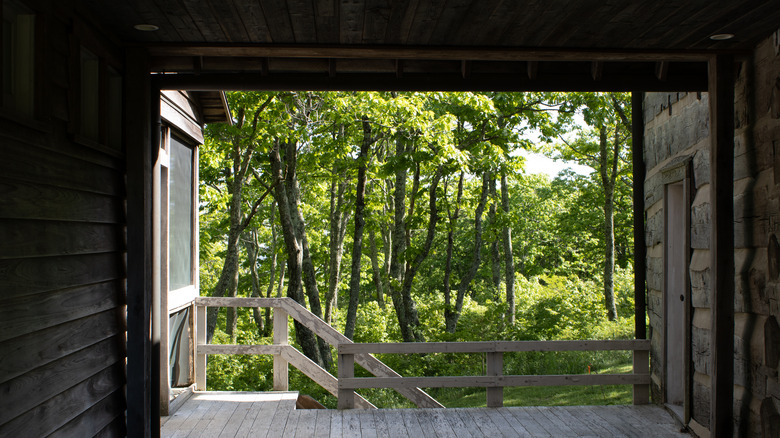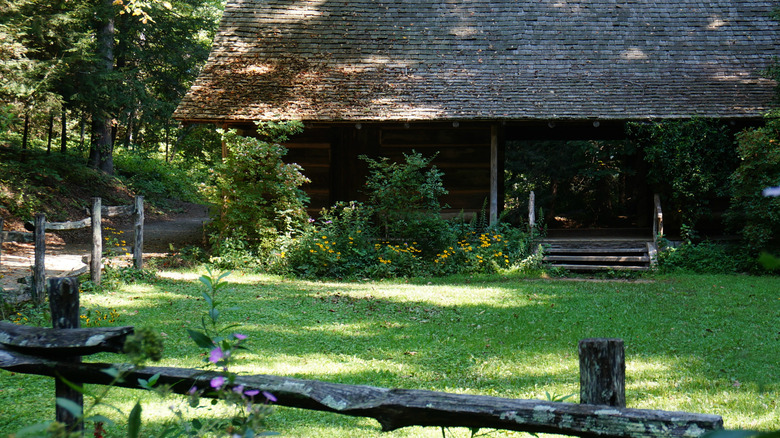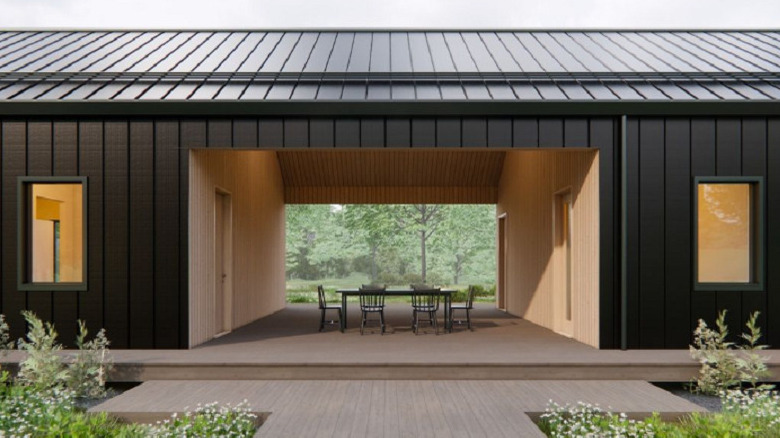HGTV's Ben Napier Explains What A Dogtrot-Style Home Is (And Why You'd Want One)
Home styles can often be informed by considerations like landscape and climate needs at the time and place they were built. During a recent remodel on HGTV's "Home Town," host Ben Napier pointed out an element in a beautiful Craftsman home under consideration by a pair of homeowners — a wide interior hallway that ran the length of the home from back door to front door, with the all the rooms branching off to the sides. Napier says in the episode, "So you see here where the center door is? That was a hallway that went all the way through to the back. Because it was so hot here, it allowed breezes to blow through."
The Craftsman's particular layout is an enclosed version of a traditional "dogtrot" home, a type of 19th-century housing that contained a central breezeway, usually open-air with a roof, that divided two separate portions of the home. In the 1800s, the earliest dogtrot houses existed in Appalachia and other rural spots, where builders were looking to maximize the amount of airflow and light that rooms could get. The two areas of the home often presented the easiest way to add rooms to a home and still retain adequate circulation. Typically only a single story tall, sometimes with a half-attic, the homes featured a central breezeway corridor that had raised flooring and a shared roof. The name — probably a later invention — is believed to have arisen from the breezeway being a perfect spot for dogs to rest in the shade during the day.
The benefits of a dogtrot style home
While today's dogtrot-style homes are quite a bit different from the earliest incarnations in the 19th century, they can still be a great approach in warmer climates for a home's indoor air quality and energy conservation, including better circulation and less cooling demands. If you have an open central breezeway, it can be a perfect sheltered space for outdoor living in more temperate climates, providing a prime spot for seating areas, dining tables, and plants. Many also feature foldable or sliding doors that open or close as needed. Like the earliest dogtrot homes, different areas can be separated, such as primary living areas from bedrooms, which offers the benefits of noise management for light sleepers.
The enclosed central hallway, like the one in the Craftsman home featured on "Home Town," is a style that can be found in a range of home designs throughout the past 200 years. While a traditional 19th-century dogtrot home usually involved an open passageway, many were later enclosed during subsequent remodels. Others were built intentionally enclosed, particularly in the less temperate Midwest, with the format still harnessing the summertime air circulation benefits of the original dogtrot homes.
Homes in this style can still benefit from greater air circulation and lower cooling bills today, allowing you to use your air conditioning far less, or even eliminate it. In addition, rooms branching off from the middle offer greater ease of layout and design. There aren't quite as many traffic pattern considerations and impediments to furniture placement. That said, there are reasons you might want to carefully consider if this house style is right for you.
Why you may not want a dogtrot house
A key drawback of any home with a central open-air breezeway, despite its friendliness in warmer weather, can be draftiness in winter months and higher heating bills. The rooms can often have far more windows or exterior walls than other houses, even when oriented around a covered passage. Similarly, if you are already using air conditioning and live in a very warm climate, the additional windows and doors can possibly work against you to keep a cool interior. The cold air that escapes every time you open a door to pass from one area to another can be less energy-efficient than in an enclosed home.
Extreme temperatures on either end can also make exterior spaces less hospitable to spend time in or pass through, which makes open breezeway dogtrot homes much less ideal for colder climates. Even in warmer regions, though, insects can be a problem, though many modern dogtrot homes incorporate screens and other preventative measures to keep them out. In addition, these homes may have smaller livable interior areas due to the breezeway taking up considerable space. An enclosed home with a long central corridor, like the one Ben Napier points out excitedly in the Craftsman home in "Home Town," is a nice halfway solution if you want the air circulation benefits of the dogtrot style without the drawbacks mentioned above.


